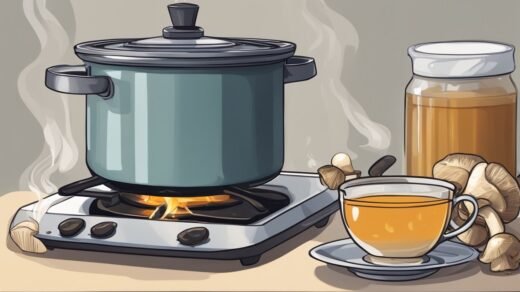Reishi mushrooms, also known as Ganoderma lucidum, are a type of medicinal mushroom that have been used for centuries in traditional Chinese medicine. They are believed to have a wide range of health benefits, including boosting the immune system, reducing inflammation, and fighting cancer. If you are interested in growing your own reishi mushrooms, it is important to understand the basic requirements for their cultivation.
One of the most important factors to consider when growing reishi mushrooms is the substrate. Reishi mushrooms are typically grown on hardwood logs or sawdust blocks, which provide the necessary nutrients for their growth. It is also important to maintain a consistently moist environment, as reishi mushrooms require high humidity levels to thrive. Additionally, proper air circulation is crucial for preventing the growth of mold and other contaminants.
While growing reishi mushrooms can be a challenging process, it is also incredibly rewarding. By following the proper cultivation techniques and providing the necessary care, you can enjoy a bountiful harvest of these unique and beneficial mushrooms. Whether you are a seasoned gardener or a beginner, growing reishi mushrooms is a fascinating and worthwhile endeavor.
Understanding Reishi Mushrooms

Reishi mushrooms, also known as Ganoderma lucidum, are a type of medicinal mushroom that has been used in traditional Chinese medicine for thousands of years. They are known for their numerous health benefits, including boosting the immune system, reducing inflammation, and promoting overall health and wellness.
Reishi mushrooms are saprotrophic bracket or shelf fungi that feed on dead or dying hardwood stumps and trees. They are usually found in temperate and tropical regions around the world, including Asia, Europe, and North America.
Reishi mushrooms have a unique appearance, with a glossy, reddish-brown cap and a woody stem. They have a bitter taste and a slightly woody aroma, which makes them less appealing for culinary purposes.
In terms of cultivation, Reishi mushrooms are considered to be more challenging to grow than other types of mushrooms. They require specific growing conditions, including high humidity, low light, and a substrate that is rich in nutrients.
However, with the right equipment and knowledge, it is possible to grow Reishi mushrooms at home. There are many resources available online that provide step-by-step instructions on how to cultivate these mushrooms, including guides and tutorials that cover everything from selecting the right substrate to harvesting and storing the mushrooms.
Overall, Reishi mushrooms are a fascinating and highly beneficial type of mushroom that is worth exploring for their medicinal properties. While they may be more challenging to grow than other types of mushrooms, the effort is worth it for those who are interested in the health benefits of these unique fungi.
Preparing the Growth Medium

To grow reishi mushrooms, the first step is to prepare the growth medium. This is the material that the mushrooms will use to grow and develop. Here are the steps to prepare the growth medium:
Selecting the Right Substrate
The substrate is the material that provides the nutrients for the mushrooms to grow. Reishi mushrooms prefer to grow on dead or dying hardwood trees such as oak, elm, beech, and maple. Some species of reishi also prefer conifers, particularly hemlock. It’s important to select a substrate that is free of any contaminants and has not been treated with any chemicals.
Sterilizing the Substrate
Once you have selected the substrate, you need to sterilize it to kill any bacteria, fungi, or other microorganisms that may be present. This is important to prevent contamination and ensure that the mushrooms can grow without competition from other organisms. There are different methods to sterilize the substrate, including:
- Boiling: This involves boiling the substrate in water for several hours to kill any microorganisms. This method is suitable for small batches of substrate.
- Pressure cooking: This involves using a pressure cooker to sterilize the substrate at high temperatures and pressure. This method is suitable for larger batches of substrate.
- Chemical sterilization: This involves using chemicals such as hydrogen peroxide or bleach to sterilize the substrate. This method is not recommended as it can leave residues that are harmful to the mushrooms.
Once the substrate is sterilized, it’s ready for inoculation with reishi mushroom spawn.
Inoculating the Substrate
Obtaining Reishi Spores or Mycelium
Before inoculating the substrate, one must obtain reishi spores or mycelium. Reishi spores can be purchased from a reputable supplier or harvested from mature reishi fruiting bodies. Mycelium can be obtained from a reishi culture or by growing reishi on agar plates. It’s important to use high-quality spores or mycelium to ensure a successful inoculation process.
Inoculation Process
Once the spores or mycelium have been obtained, the next step is to inoculate the substrate. The substrate can be made up of a variety of materials, including sawdust, straw, or logs. The substrate should be sterilized before inoculation to prevent contamination.
To inoculate the substrate, mix the spores or mycelium with the substrate and place it in a container with ventilation holes. The container should be kept in a warm, humid environment with indirect sunlight for several weeks. During this time, the mycelium will colonize the substrate, and white, web-like growth will appear.
Consistency is important during the inoculation process. The amount of spores or mycelium used should be consistent, as well as the temperature and humidity of the environment. It’s also important to keep the substrate moist during the colonization process.
In conclusion, inoculating the substrate is a crucial step in growing reishi mushrooms. Obtaining high-quality spores or mycelium and maintaining consistency during the inoculation process are key to a successful harvest.
Incubating the Culture
Setting Up the Incubation Area
Before starting the incubation process, it’s important to have a designated area with proper temperature and humidity control. The ideal temperature for incubating Reishi cultures is between 70-80°F (21-27°C). A humidity level of around 90% is also recommended for optimal growth.
To achieve these conditions, consider using a temperature-controlled incubator or a designated room with a heating and cooling system. You can also use a humidifier or a misting system to maintain the required humidity level.
It’s important to keep the incubation area clean and sterile to prevent contamination. Use a disinfectant to clean all surfaces and equipment before use. Consider using a laminar flow hood or a glove box to further reduce the risk of contamination.
Monitoring Growth Conditions
Once the incubation area is set up, it’s important to monitor the growth conditions regularly. Check the temperature and humidity levels daily and make adjustments as needed. Keep a log of these measurements to track the progress of the culture.
It’s also important to check the culture for signs of contamination or abnormal growth. If you notice any discoloration, strange odors, or unusual growth patterns, it may indicate contamination. In this case, remove the contaminated culture and sterilize the area before starting a new culture.
By following these steps, you can successfully incubate your Reishi culture and create a healthy and productive mushroom culture. Remember to maintain a sterile environment and monitor the growth conditions regularly to ensure optimal growth.
Fruiting and Harvesting
Inducing Fruiting Conditions
Once the mycelium has fully colonized the substrate, it is time to initiate the fruiting stage. This is done by exposing the substrate to the appropriate environmental conditions. Reishi mushrooms prefer a temperature range of 60-80°F (15-27°C) and a humidity level of around 90%. To achieve these conditions, a fruiting chamber can be created by placing the substrate in a plastic bag or container and misting it regularly to maintain high humidity. Alternatively, a greenhouse or other enclosed space can be used.
Harvesting Reishi Mushrooms
Reishi mushrooms will begin to fruit after several weeks of exposure to the appropriate conditions. The fruiting bodies will appear as small, white bumps on the surface of the substrate that will gradually grow into large, flat, reddish-brown caps. It is important to harvest the mushrooms before they release their spores, as this can reduce the potency of the fruiting bodies.
To harvest the mushrooms, use a sharp knife or pair of scissors to cut them off at the base of the stem. The mushrooms can then be dried for later use or used fresh in recipes. It is important to handle the mushrooms gently to avoid damaging them, as they are delicate and can bruise easily.
Overall, growing reishi mushrooms can be a rewarding and relatively simple process. By following the proper steps and maintaining the appropriate environmental conditions, it is possible to produce high-quality fruiting bodies that can be used for a variety of medicinal and culinary purposes.
Post-Harvest Processing
Drying and Curing
After harvesting reishi mushrooms, it is important to properly dry and cure them to preserve their medicinal benefits. Begin by gently brushing off any dirt or debris from the surface of the mushroom. Then, cut the mushroom into thin slices to facilitate the drying process.
The ideal temperature for drying reishi mushrooms is between 90-100°F (32-38°C), with low humidity. You can use a dehydrator or an oven with the door cracked open to achieve this temperature. It is important to dry the mushrooms until they are completely brittle, which can take anywhere from 12-24 hours depending on the size of the slices.
Once the mushrooms are fully dried, they should be cured for at least 2-4 weeks in an airtight container to ensure that they are fully dried and to allow the flavor to develop. You can store the cured mushrooms in an airtight container for up to a year.
Storing for Longevity
To store reishi mushrooms for long-term use, it is important to keep them in a cool, dry place away from direct sunlight. You can store them in an airtight container or a paper bag to allow air to circulate.
It is important to check the mushrooms periodically for any signs of moisture or mold. If you notice any, discard the affected mushrooms immediately to prevent the spread of mold.
With proper post-harvest processing and storage, you can enjoy the medicinal benefits of reishi mushrooms for months or even years to come.




